Hyundai Elantra Camshaft
Position Sensors Replacement Guide
How to change a failing or faulty
camshaft position sensor in a 6th generation 2017 to 2020 Hyundai Elantra sedan.
By Paul B. Michaels Author & Photographer Auto Mechanic Since 1989 |
||
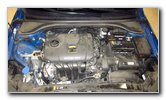 2018 Elantra Nu 2.0L I4 |
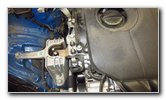 Front Left Corner Bolt |
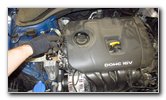 Loosen Counterclockwise |
| This automotive
maintenance tutorial was specifically written to assist owners of the 6th
generation (2017, 2018, 2019, 2020 and probably also the upcoming 2021 model
year) Hyundai Elantra sedan in changing a faulty or failing camshaft
position sensor in the Nu MPI 2.0 liter Atkinson cycle inline four cylinder
engine. The procedure should be the same or very similar for the Kappa 1.4L
I4 engine and the Gamma 1.6L turbocharged I4 engine. Owners of other Hyundai, Genesis or Kia vehicles such as the Sonata, Accent, Veloster, Ioniq, Kona, Nexo, Venue, Tucson, Santa Fe, Palisade, G70, G80, G90, Soul, Sportage, Niro, Sorento, Telluride, Rio, Forte, Optima, Stinger, Cadenza, K900, Sedona and Seltos may also find these DIY instructions to be helpful. The Nu MPI 2.0L Atkinson cycle I4 engine is equipped with two camshaft position sensors which are both genuine OEM part number Hyundai 39350-2E200. Please use the Amazon Part Finder website to verify the correct part number and check the part number printed on the old sensor in your vehicle before purchasing a new one. The tools needed to access and replace the two camshaft sensors include a 10mm socket with a 1/4" drive ratchet or a standard 10mm wrench. A few of the symptoms of an engine with a failing or faulty camshaft position sensor (or "CPS") include hard starting, rough idling, stalling, hesitating, reduced fuel economy (lowered MPG), poor acceleration, jerking, surging, being stuck in one gear or having to drive in "limp mode". If you see a CEL (check engine light) or SES (service engine soon) warning on the gauge cluster, use an OBD2 scanner (also known as an OBDII scan tool) to check for a diagnostic trouble code. Some of the DTCs that are related to the camshaft position sensor include P0340, P0341, P0342, P0343, P0344, P0345, P0346, P0347, P0348, P0349, P0365, P0366, P0367, P0368, P0369, P0390, P0391, P0392, P0393 and P0394. The first two steps are to open the hood and then locate the silver metal bolt on the front left (passenger side) corner of the black plastic engine cover. Loosen the bolt by turning it in the counterclockwise direction with a 10mm socket and 1/4" drive ratchet or a 10mm wrench. |
||
|
|
||
 Engine Cover Bolt |
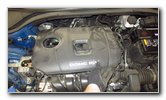 Pull Off Plastic Cover |
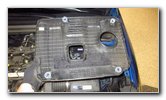 Rubber Friction Fasteners |
| Spin out the bolt
the last few turns by hand to prevent from having it fall down into the
engine bay and become lost. Set the bolt aside in a safe place. The cover is still held in place by four rubber friction fasteners attached to metal pegs or "spikes" on the top of the engine. Gently pull up the rear edge and the front edge of the cover to release the friction fasteners. Set the cover aside in a safe place. |
||
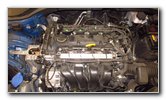 Valve Cover Exposed |
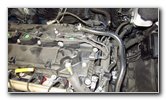 Right (Driver) Side |
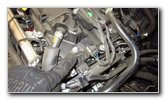 Front Right Sensor # 1 |
| Move to the right
(driver) side of the engine.
Locate the two camshaft position sensors at the far right edge of the black plastic valve cover. In the pictures above and below, I'm pointing to the front and rear sensors. |
||
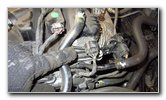 Rear Right Sensor # 2 |
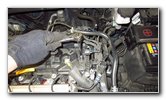 Loosen Counterclockwise |
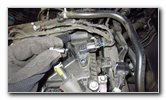 Single Bolt Removed |
| If you have access
to compressed air or a wet/dry shop vacuum, clean off the top of the engine
to help reduce the chance of having dust or debris fall into the engine. I recommend only changing one sensor at a time to help further reduce the risk of having dust or debris fall down into the valve cover and also for your troubleshooting process to see which of the two sensors is faulty or has failed. Push in the release tab on the electrical connector before sliding it straight off the old sensor. (I mistakenly did this step after removing the bolt.) Loosen the single bolt that secures the sensor in place by turning it in the counterclockwise direction with a 10mm socket and a 1/4" drive ratchet. Spin out the bolt the last few turns by hand to prevent from having it fall down into the engine bay. Set the bolt aside in a safe place. |
||
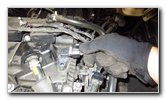 Push In Release Tab |
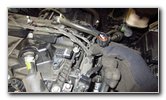 Disconnect Power Plug |
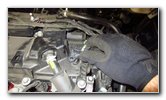 Gently Rotate Sensor |
| (If you haven't
already disconnected the power plug, push in the release tab and slide it
off the base of the old sensor.) Gently rotate the old sensor back and forth a few times to make sure the rubber o-ring gasket isn't stuck or "frozen" to the valve cover. Carefully pull the old sensor straight out of the valve cover. Try to avoid using excessive force. The sensor should come out relatively easily especially if you rotated it back and forth a few times. |
||
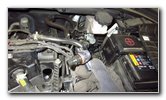 Old Sensor Removed |
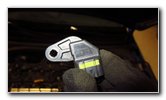 OEM Hyundai / Kia Part |
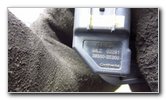 Part # 39350-2E200 |
| The OEM (original
equipment manufacturer) sensors in this 2018 Elantra with the Nu MPI 2.0L I4
engine was marked as part number Hyundai Kia MLZ 02291 39350-2E200
Continental. I recommend buying the same genuine Hyundai 39350-2E200 camshaft position sensors. |
||
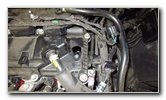 Empty Sensor Port |
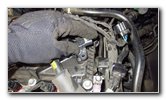 Install New Sensor |
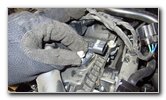 Spin In Bolt By Hand |
| Apply a small
amount of new oil to the rubber o-ring gasket on the new sensor. Lubricating the o-ring will help it form a better seal, prevent oil leaks and also prevent it from tearing or breaking during installation or removal in the future. Carefully insert the new sensor into the opening in the valve cover. Gently rotate the sensor until the bolt hole lines up with the corresponding hole in the valve cover. Spin in the bolt a few turns by hand in the clockwise direction to help prevent it from becoming cross threaded. |
||
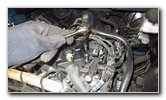 Tighten Bolt Clockwise |
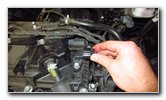 Push On Power Plug |
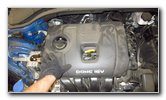 Push On Engine Cover |
| Tighten the bolt in
the clockwise direction with the 10mm socket and a 1/4" drive ratchet until
it is snug. Try to avoid over tightening the bolt to prevent from cracking the sensor's plastic housing. Push the electrical connector straight on to the base of the new sensor. You should feel or hear the power plug "click" securely into place. Repeat the process if you need to replace the other sensor. Line up the four rubber friction fasteners on the underside of the plastic cover with their corresponding pegs on the top of the engine. Push the engine cover down into place. |
||
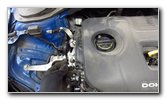 Spin In Bolt - Front Left |
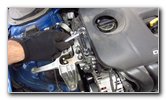 Tighten Bolt Clockwise |
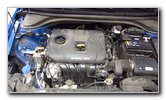 Camshaft Sensor Replaced |
| Spin in the bolt at
the front left corner of the engine cover a few turns by hand in the
clockwise direction. Tighten the bolt in the clockwise direction with the 10mm socket and a 1/4" drive ratchet until it is snug. Try to avoid over tightening the bolt to prevent from cracking the plastic engine cover. Use an OBD2 scanner to clear any camshaft position sensor related diagnostic trouble codes. Start the engine and listen closely for any strange sounds that might indicate a defective sensor or a disconnected electrical connector. Be sure to write down the sensor change in your vehicle's service records. For more, please check out all of my
2017-2020 Hyundai Elantra DIY Repair & Maintenance Guides. |
||
| If you found this guide to be helpful,
please consider making a small donation by clicking on the PayPal.com
"Donate" button located to the right of this paragraph. Thank you!
(Note: I am not a registered charity. Donations are not tax deductible.) |

